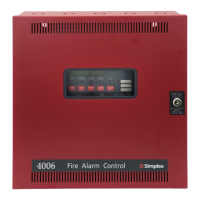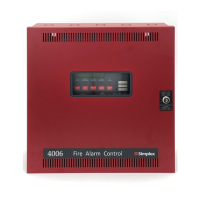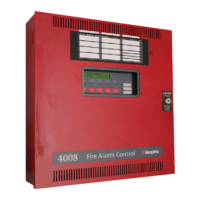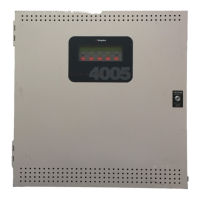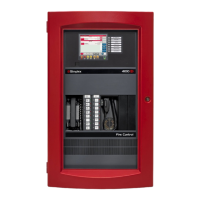2-11
{xe "4100U: card configuration"}
The CPU, SPS, and all other modules to be mounted in the FIP cabinets must be
configured to operate correctly in the system via their DIP switch and jumper ports. This
section describes the hardware configuration for the CPU and SPS, since they will always
be used in the CPU bay.
The Master motherboard must be jumpered as follows:
{xe "card configuration: CPU"}{xe "CPU motherboard: configuring"}
P9 determines whether the RUI SHIELD signal is connected to 24 C or Earth:
Position 1 – 2: SHIELD to 24 C (default). Set to this position unless the system
uses a TrueAlert Power Supply (not listed for use in Australia).
Position 2 – 3: SHIELD to Earth. Set to this position only if the system uses a
TrueAlert Power Supply.
Note: Some devices that connect to RUI have inherently grounded shield
terminals, in which case 24 C cannot be used. If 24 C is used, a
Negative Ground Fault will occur.
P10/P11: P10 is associated with Port 1 and P11 is associated with Port 2. P10 and P11 are
used to set the CPU motherboard up to be attached to either a network card or a RS-
232/2120 card:
Position 1 – 2: Network card (NIC) fitted to CPU motherboard (default).
Position 2 – 3: RS-232 card fitted to CPU motherboard.
The CPU card must be jumpered as follows:
{xe "card configuration: CPU (4100U)"}{xe "CPU motherboard: configuring"}
P1 is used for engineering diagnostics (COMLAB):
Position 1 – 2 : Download or no connection.
Position 2 – 3 : Diagnostic mode.
P3 configures the RAM battery as ON or OFF:
Position 1 – 2 : ON (use for normal operation).
Position 2 – 3 : OFF.
The SPS must be configured as follows:
{xe "card configuration: SPS"}{xe "system power supply (SPS): configuring"}
SW1: Using DIP switch SW1, set the SPS slave address. Use the address table in
Appendix A.
P2: If the SPS IDNet outputs are being used, you may change P2 to configure the IDNet
shield connection:
Position 1 – 2 (bottom) : Connects the shield to 0 V (default).
Position 2 – 3 (top) : Connects the shield to earth ground.
P3 configures relay 3 on the 4100-6033 Alarm Relay Card:
Position 1 – 2 (top) : Removes fault monitoring on relay 3 (default).
Position 2 – 3 (bottom) : Makes relay 3 activate when there is a fault.
P1: Earth connect jumper:
Position 1 – 2 (rhs): Enables Earth fault monitoring. Set to this position unless the
system uses a TrueAlert Power Supply under common 0V.
Position 2 – 3 (lhs): Disables Earth fault monitoring. Set to this position only if the
system uses a TrueAlert Power Supply under common 0V.
Continued on next page
Step 3. Configuring Cards (4100ES)
Overview
Master Motherboard
Configuration
CPU Card
Configuration
SPS Configuration
